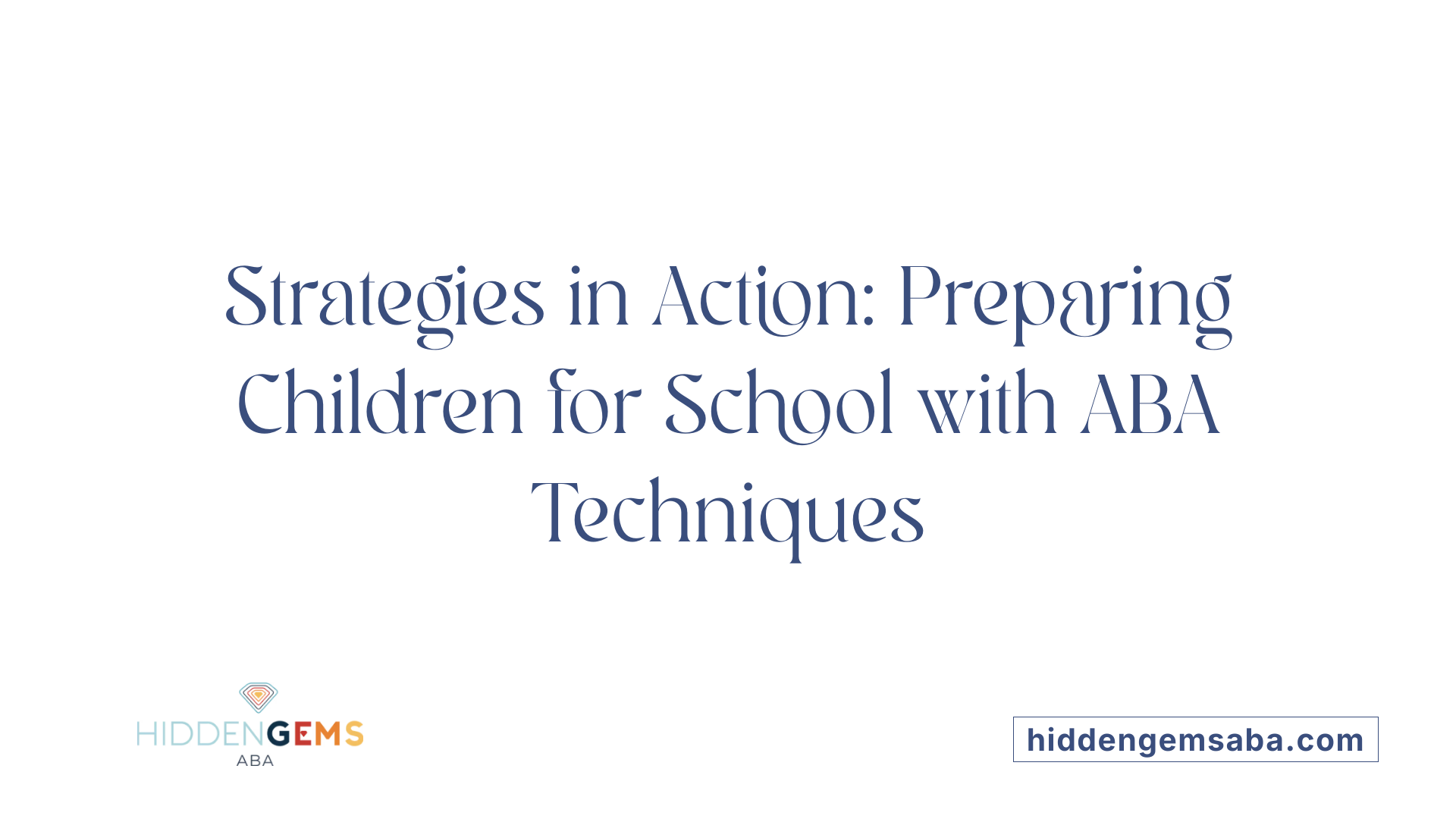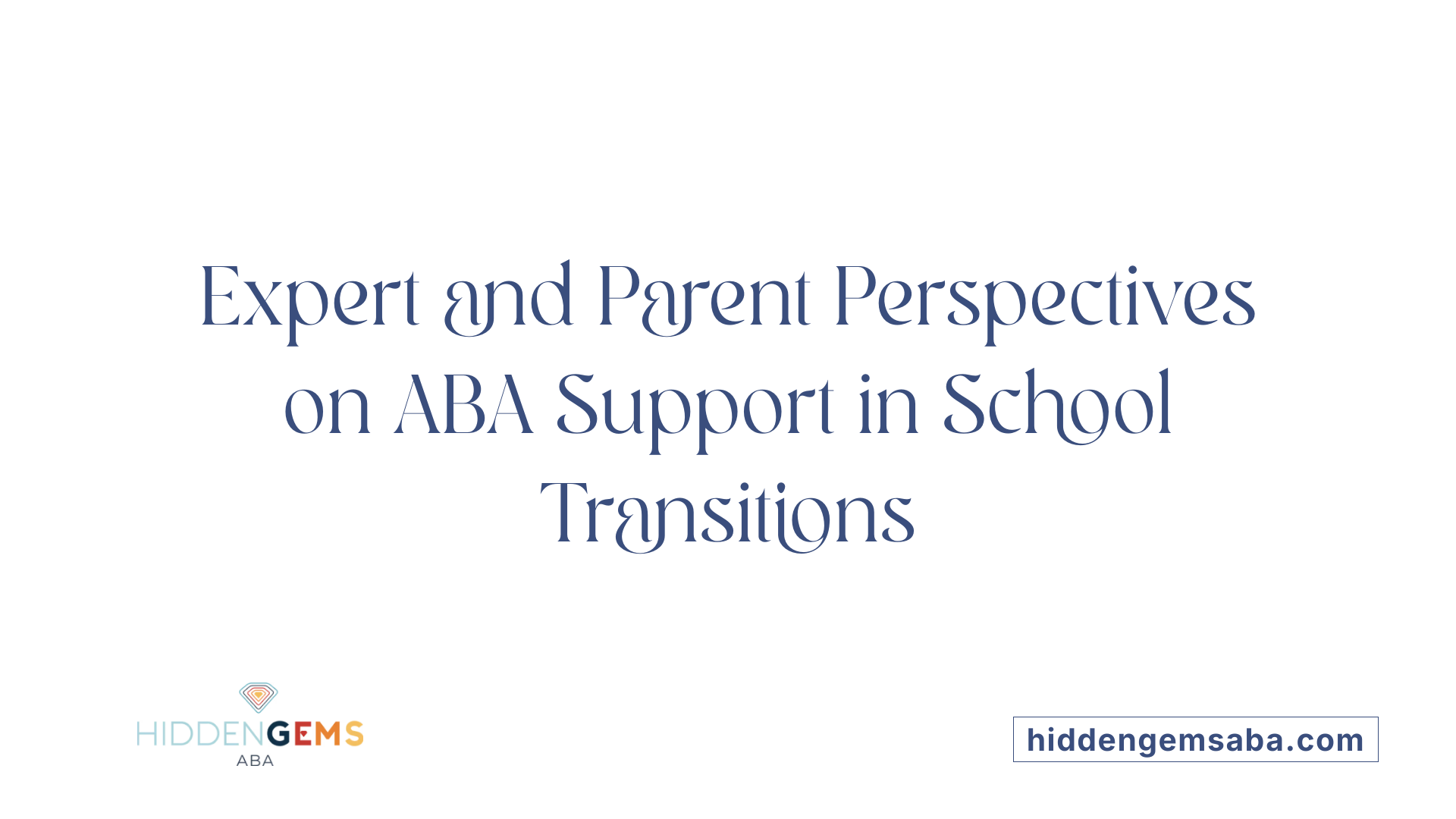Understanding the Role of ABA in School Transitions
Transitioning to a new school environment can be challenging for children with autism, often accompanied by anxiety, unfamiliar routines, and social complexities. Applied Behavior Analysis (ABA) therapy offers structured, evidence-based strategies that prepare children for these changes, fostering confidence and independence. This article explores how ABA therapy supports children during school transitions, emphasizing effective strategies, skills development, and collaborative approaches that facilitate smoother adjustments.
The Foundation of ABA in Transition Support

Why is Creating an Individualized Transition Plan Important?
A tailored approach is crucial because every child with autism has unique skills, challenges, and preferences. Transition planning ensures that the specific needs of the child are addressed, helping them shift smoothly from ABA programs to school environments.
Detailed planning involves assessing the child’s current abilities, setting realistic goals, and determining the best ways to support them through the transition. This might include developing social stories, visual supports, and routines that mirror the upcoming school day. Having an individualized plan reduces anxiety and builds confidence by preparing children for what to expect.
How Do ABA Providers, Families, and Schools Collaborate?
Collaboration forms the backbone of successful transitions. ABA providers work closely with families to gather insight into the child's strengths and areas for improvement. They also communicate regularly with school staff to share strategies, progress, and behavior plans.
Pre-meetings are common, where all parties discuss potential placements, safety concerns, timelines, training needs, and ongoing ABA involvement. These meetings help ensure everyone is aligned in supporting the child’s needs.
Developing a Personal Service Plan to Support Transition
A comprehensive service plan is vital to coordinate efforts and resources. This plan typically includes details about ancillary services like speech or occupational therapy, information sharing protocols, behavior programming, and strategies for supporting social and daily living skills.
For example, it might specify the use of visual schedules to outline daily routines, timers for transition warnings, or positive reinforcement methods to encourage cooperation. The plan also details how to handle emergencies and ongoing communication channels.
Supporting Children With ABA During School Transitions
ABA therapy plays a significant role in preparing children for school changes. It teaches skills like following routines, managing transitions, and communicating needs. Visual schedules help children understand the sequence of daily activities and reduce feelings of uncertainty.
Timers and countdown cues prepare children mentally for upcoming transitions, while reinforcement strategies motivate them to stay engaged. Incorporating transition objects or social stories can also ease emotional adjustments.
Practicing Skills in a Step-by-Step Manner
Role-playing and gradual exposure are used to improve flexibility and adaptation. Repeated practice helps children become comfortable with changes, making adjustments less stressful.
Enhancing Social and Independence Skills
ABA focuses on developing social skills such as initiating conversations, taking turns, and understanding social cues. It also promotes independence in daily routines like morning and bedtime habits, lunchtime, and seeking help.
These skills not only support immediate school success but also foster long-term independence and confidence.
| Aspect | Strategy | Purpose | Additional Details |
|---|---|---|---|
| Routine understanding | Visual schedules | Reduce anxiety | Clear, step-by-step visuals of daily activities |
| Transition cues | Timers, countdowns | Prepare for upcoming change | Visual or auditory signals to signal transition |
| Behavior support | Positive reinforcement | Encourage cooperation | Rewards and praise for desired behaviors |
| Emotional security | Transition objects | Comfort during change | Favorite toy or item to provide stability |
| Skill generalization | Collaboration, practice | Apply skills across settings | Consistency among home, therapy, and school environments |
Overall, the goal of integrating ABA strategies during school transitions is to ensure that children can generalize skills, manage anxieties, and develop confidence. These efforts help foster a smoother, more positive transition—laying the foundation for continued success in new educational environments.
Strategies in Action: Preparing for School Transitions with ABA

What strategies are used in ABA therapy to facilitate school and routine transitions?
ABA therapy incorporates a variety of tried-and-true strategies to help children smoothly transition to school and daily routines. Visual supports, such as visual schedules and social stories, play a central role. These tools help children understand what to expect throughout their day, reducing uncertainty and anxiety.
Timers and countdown warnings enable children to mentally prepare for upcoming changes, making transitions more predictable. Behavioral reinforcement techniques encourage cooperation and positive behavior during these changes. Specific tasks, like packing backpacks or using lockers, are broken down into steps through task analysis, with children practicing these skills in a structured way.
Preparing children early is vital. Therapists work with families to practice routines and explore the school environment beforehand. This preparation builds confidence and familiarity. Furthermore, collaboration with families and educators ensures that strategies are consistent across home and school settings and tailored to individual needs.
Sensory supports and teaching coping strategies help children manage sensory input and emotional responses, making transitions less overwhelming during busy school days. All these combined practices aim to create a predictable, supportive environment that encourages children’s independence and comfort during school changes.
What skills are developed through ABA therapy that help children adapt to school environments?
ABA therapy enhances crucial skills necessary for children to thrive in school settings. Communication skills—such as speaking, listening, and gesturing—are strengthened, enabling children to participate actively in class and social interactions.
The development of social skills also forms an essential part of therapy. Children learn to share, take turns, interpret social cues, and work in groups, which boosts peer relationships. Self-regulation and emotional coping strategies are taught to help children manage their feelings and reactions during transitions and routine activities.
Independence is a focus; children are trained to follow instructions, complete tasks, and handle personal belongings without constant support. These skills collectively foster a smoother daily routine and promote autonomy.
Ultimately, ABA therapy aims to generalize these skills across settings—home, school, and community—ensuring that children feel confident and capable wherever they go. This comprehensive skill development lays the foundation for successful school experiences and lifelong learning.
Developing Critical Skills for School Success
 Transitioning from ABA programs to school settings involves a focus on developing essential skills that support success in a structured environment. ABA therapy plays a vital role in helping children with autism acquire communication, social, and self-regulation skills.
Transitioning from ABA programs to school settings involves a focus on developing essential skills that support success in a structured environment. ABA therapy plays a vital role in helping children with autism acquire communication, social, and self-regulation skills.
Through targeted interventions, children learn to express themselves verbally or through gestures, listen attentively, and understand instructions — all fundamental for classroom participation. Socially, ABA supports behaviors such as sharing, taking turns, and interpreting non-verbal cues, which foster positive interactions with peers.
Self-regulation techniques taught via ABA include managing emotions and behaviors, coping with transitions, and following routines consistently. These skills enable children to handle the daily ebb and flow of school life with greater ease.
Independence is another critical area reinforced by ABA therapy. Children are guided in completing routines like morning and bedtime tasks, navigating lunch breaks, and requesting assistance when needed. These routines build confidence and foster autonomy.
An important goal of ABA is skill generalization — ensuring that children apply their learned abilities across multiple environments. This means that skills honed in therapy or at home are consistently used at school, in community settings, and during social interactions.
What skills are developed through ABA therapy that help children adapt to school environments?
ABA therapy develops a broad set of skills. It improves communication, teaching children to use words, gestures, and listening skills that support engagement and comprehension. The therapy also nurtures social skills such as initiating conversations, understanding social cues, and engaging in group activities, all of which foster peer relationships.
Furthermore, ABA helps children manage their emotions and behaviors through strategies like visual schedules, timers, and positive reinforcement. These tools help children anticipate and cope with changes, reducing anxiety and behavioral issues. Skills for independence — following instructions, managing personal items, and completing tasks — are also emphasized, preparing children for the structured demands of school.
What outcomes can be expected from ABA therapy in helping children manage school transitions effectively?
Children receiving ABA therapy often experience smoother transitions into school environments. The therapy’s focus on communication and social skills ensures children can interact effectively with teachers and peers. Using visual supports, social stories, and routines helps children understand new settings and expectations, which diminishes anxiety and disruptive behaviors.
Techniques such as graduated exposure, clear warnings before transitions, and self-management strategies empower children to handle changes more independently. Customized plans crafted in collaboration with families and educators maximize these outcomes. As a result, children tend to adjust more quickly and participate more actively in school life, gaining confidence and resilience that support ongoing development.
The Endorsement and Perspectives on ABA in School Transitions

What do parents and experts say about the role of ABA therapy in supporting children during school transitions?
Many parents and specialists agree that ABA therapy plays a vital role in helping children with autism adjust to new school environments. They highlight how ABA techniques teach children essential skills such as communication, social interaction, and behavioral regulation, which are crucial for a successful transition.
ABA methods include the use of visual schedules, social stories, and routine practice. These strategies help children understand daily routines, reduce anxiety, and build confidence to face change. For example, visual aids provide clarity about what to expect during the day, easing stress and improving cooperation.
Collaboration is seen as a cornerstone for success. ABA providers often work closely with families and schools to develop tailored transition plans. Regular meetings and ongoing communication facilitate consistency and reinforce learned skills across different settings.
Home-based ABA therapy allows individualized interventions that directly target skills necessary for school, such as sitting through lessons, following directions, and engaging with peers. Additionally, continuous data collection ensures that interventions are personalized and adapted according to each child's progress.
Overall, ABA therapy is regarded as an evidence-based approach that not only prepares children for the demands of school but also boosts their long-term independence and confidence. Families and experts alike see it as a supportive framework that bridges the gap between home and school, fostering smoother transitions for children with autism.
Supporting a Smooth Transition: The Role of ABA Therapy
ABA therapy stands out as a comprehensive approach to assist children with autism in navigating the complexities of school transitions. By developing vital skills, implementing targeted strategies, and fostering collaboration among families, educators, and therapists, ABA helps children approach new environments with confidence and independence. The personalized, data-driven nature of ABA ensures that each child's unique needs are addressed, paving the way for successful integration into their new school community. As research and practice continue to evolve, ABA’s role in smooth transitions remains a cornerstone of supporting children’s educational journeys.
References
- Transition Checklist: Moving From ABA Programs to School ...
- Making Transitions Easier: ABA Tools for Everyday Routines
- How In-Home ABA Therapy Helps Children Transition to ...
- ABA Therapy and Back-to-School Transitions
- How Can We Help Kids With Transitions?
- ABA Therapy vs School: What's Best for Your Child?
- Transition Strategies for Autistic Students in the Classroom






